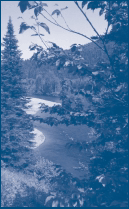|
|
||||||||||
|
|
|
|
|
|
||||||
|
|
||||||||||


Six Facts About Canada's Seal Hunt
- ... support the tradition of hunting
- ... ensure a humane hunt
- ... prohibit the commercial hunt of seal pups
- ... enforce against violations of seal hunt regulations
- ... take survival of seal species into account
- ... research seals and their ecosystems

Canada takes its role as a steward of the natural environment very seriously and there are a number of ways in which it works to protect its wild landscapes, natural resources and wildlife.
Canada remains committed to the conservation and sustainability of its ecosystems for generations to come. Canada ensures the protection of species at risk and regulates hunting where animal populations are abundant, as in the case of seals.
Today, Canada's seal hunt remains a sustainable activity based on sound conservation principles. The Government of Canada regulates the seal hunt through its Department of Fisheries and Oceans. The proportion of animals that may be hunted is based on sound conservation principles, as well as a commitment to peer-reviewed scientific advice to help ensure the continued health and abundance of seal populations.
While Canada certainly respects individuals' right to oppose the seal hunt, many myths about the seal hunt remain. Canada encourages people to form their opinions based on the facts.
Canada does...
1 ... support the tradition of hunting

Canada establishes regulations for hunting in the context of its healthy, abundant wildlife populations. In Canada, seals are considered an important natural resource, one that generates many life-enhancing products - leather, oil, handicrafts, food for human and animal consumption, not to mention seal oil capsules rich in Omega-3.
In 2003, the estimated value of seal-based products was over $40 million. While recognizing the economic benefits of the hunt for thousands of families in Eastern Canada's rural coastal communities, Canada also takes into account the rights of Canadian Aboriginals and Inuit, for whom the seal hunt is an important right, a source of food, culture and tradition. Canadian regulations require the fullest possible use of seals.
2 ... ensure a humane hunt
The world continues to use animal-based food and clothing. Canada works to ensure its animals are killed quickly and humanely by implementing strict regulations. In the case of seals, Canada has researched the methods used - guns and hakapiks, which originated in the traditions of First Nations and Inuit peoples - to ensure that methods used compare favourably with those used to kill any other wild or domestic animal.
Canada requires a clear determination of death (blinking eye reflex test) before seals can be processed. A study by independent members of the Canadian Veterinary Medical Association found that virtually all seals taken during the hunt are in fact killed in a humane manner.
 3 ...
prohibit the commercial hunt of seal pups
3 ...
prohibit the commercial hunt of seal pups
The seals hunted today must be independent, self-reliant animals. Although gruesome images of nursing seal pup hunting continue to be circulated around the world, in fact, the commercial hunt of nursing seal pups is banned in Canada.
4 ... enforce against violations of seal hunt regulations
Fishery Officers closely monitor the hunt to ensure sealers comply with Canada's Marine Mammal Regulations. They monitor catches, ensure humane harvesting practices, and enforce regulations and licence conditions. The Government of Canada has laid over 200 charges against sealers since 1996. Canada's enforcement of seal hunt regulations is thorough and comprehensive - it includes: aerial patrols, vessel patrols, dockside inspections of vessels at landing sites and inspections at buying/processing facilities. Observers are also deployed on the ice and on many vessels to monitor compliance with regulations.
5 ... take survival of seal species into account

There are six species of seals found in Atlantic Canada. Four of these species - harp, hooded, grey and ringed - may be hunted commercially. Among these species, the number of animals that may be hunted is established in proportion to the health and abundance of each population.
Scientific research confirms that Canada's seal hunt does not negatively impact the sustainability of its seal species. History also supports this evidence, as the harp seal population, for example, has burgeoned by several million animals in recent decades, despite continued hunting.
6 ... research seals and their ecosystems
Canada has maintained an active seal research program for many years to achieve a better scientific understanding of seals, such as population dynamics, trends in reproductive performance, survival, migration, diving behaviour and diet analysis.
Today, Canada is also looking at research on how seals interact with other components in the marine ecosystem, including the relationship between fish stocks and seals. This kind of research not only promotes a better understanding of seals and marine ecosystems, but will help ensure balance in Canada's ongoing resource management following an ecosystem-based approach.
